PORTLAND, Ore. — We’ve all been there. You’re eyeing that deli meat in the fridge, wondering if it’s okay to eat.
The package hasn’t been opened, but the “best by” date came and went about a week ago. So what do you do?
Expirations dates on food packaging can be confusing. Consumers often mistakenly rely on “sell by” and “use by” dates to tell whether a food is safe to eat. Experts say those date labels actually have nothing to do with the risk of food poisoning. Typically, food producers come up with their own date labels based on when the product is at its freshest and most flavorful.
“A lot of labeling is clearly telling you to use it by this date. It will taste the best, but actually it is perfectly safe to use substantially beyond that date,” said retail expert Tom Gillpatrick of Portland State University.
A 2013 report from the Natural Resources Defense Council and Harvard Law School’s Food Law and Policy Clinic found many Americans prematurely threw out food because of confusion over expiration dates.
“In the United States, we throw away roughly 40 percent of all the food we produce,” Gillpatrick said.
The U.S. Food and Drug Administration doesn’t regulate expiration dates except on baby formula. Recently proposed federal legislation would create a standard date and wording that would help to signal when food could actually make you sick.
Oregon requires “pull dates” on perishable foods, including eggs, milk and raw meat. If still in good quality, foods with expired dates can be separated and offered for sale.
Oregon State University Extension Service and the United States Department of Agriculture provided the following explanation of wording found on food packaging:
“Sell by” dates tell the store how long to offer the product for sale. For best quality, you should buy the food before that date.
“Best if used by (or before)” dates estimate how long the product will be have best quality or flavor. It is not a purchase or safety date.
“Use by” dates are the endpoint of the time when the food is expected to be at peak quality.
What can you eat after their end dates? When you should toss these common foods:
Eggs: For best quality, use eggs within 3 to 5 weeks of the date you purchase them. The “sell by” date will usually expire during that length of time, but the eggs are perfectly safe to use.
Bread: Packaged bread is good after its “best by” date. If you spot mold on one slice of bread, throw out the whole loaf.
Breakfast cereal: It may lose flavor, but it is safe to eat several weeks after the “best by” date has passed.
Crackers: A box of crackers may turn stale after its “sell by” date but it won’t make you sick.
Milk: Milk will last after its “sell by” date but be sure to smell it. If you see changes in texture or consistency, toss it. Chunky or lumpy milk is bad.
Dried pasta: Pasta noodles will stay good for years beyond their expiration date.
Deli meat: Unopened deli meat will stay good for two weeks after purchase. If you open it, use the deli meat within 3 to 5 days. If it has a foul odor, throw it out.
Canned foods: Canned food items will last for years beyond their “best by” date, as long as the cans don’t have any dents or rust.


